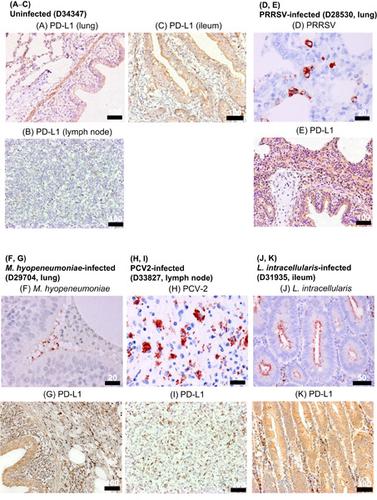当前位置:
X-MOL 学术
›
Immun. Inflamm. Dis.
›
论文详情
Our official English website, www.x-mol.net, welcomes your feedback! (Note: you will need to create a separate account there.)
Programmed death-ligand 1 expression in swine chronic infections and enhancement of interleukin-2 production via programmed death-1/programmed death-ligand 1 blockade
Immunity, Inflammation and Disease ( IF 2.493 ) Pub Date : 2021-08-20 , DOI: 10.1002/iid3.510 Otgontuya Ganbaatar 1 , Satoru Konnai 1, 2 , Tomohiro Okagawa 2 , Yutaro Nojima 1 , Naoya Maekawa 2 , Yoshiki Ichikawa 3 , Atsushi Kobayashi 3 , Tomoyuki Shibahara 4, 5 , Yojiro Yanagawa 3 , Hidetoshi Higuchi 6 , Yukinari Kato 7, 8 , Yasuhiko Suzuki 2, 9 , Shiro Murata 1, 2 , Kazuhiko Ohashi 1, 2
Immunity, Inflammation and Disease ( IF 2.493 ) Pub Date : 2021-08-20 , DOI: 10.1002/iid3.510 Otgontuya Ganbaatar 1 , Satoru Konnai 1, 2 , Tomohiro Okagawa 2 , Yutaro Nojima 1 , Naoya Maekawa 2 , Yoshiki Ichikawa 3 , Atsushi Kobayashi 3 , Tomoyuki Shibahara 4, 5 , Yojiro Yanagawa 3 , Hidetoshi Higuchi 6 , Yukinari Kato 7, 8 , Yasuhiko Suzuki 2, 9 , Shiro Murata 1, 2 , Kazuhiko Ohashi 1, 2
Affiliation

|
Chronic infections lead to the functional exhaustion of T cells. Exhausted T cells are phenotypically differentiated by the surface expression of the immunoinhibitory receptor, such as programmed death-1 (PD-1). The inhibitory signal is produced by the interaction between PD-1 and its PD-ligand 1 (PD-L1) and impairs the effector functions of T cells. However, the expression dynamics of PD-L1 and the immunological functions of the PD-1/PD-L1 pathway in chronic diseases of pigs are still poorly understood. In this study, we first analyzed the expression of PD-L1 in various chronic infections in pigs, and then evaluated the immune activation by the blocking assay targeting the swine PD-1/PD-L1 pathway.
中文翻译:

程序性死亡配体 1 在猪慢性感染中的表达和通过程序性死亡 1/程序性死亡配体 1 阻断增强白细胞介素 2 的产生
慢性感染导致 T 细胞功能衰竭。耗尽的 T 细胞通过免疫抑制受体的表面表达进行表型分化,例如程序性死亡 1 (PD-1)。抑制信号由 PD-1 与其 PD-配体 1 (PD-L1) 之间的相互作用产生,并损害 T 细胞的效应子功能。然而,PD-L1的表达动态和PD-1/PD-L1通路在猪慢性疾病中的免疫功能仍知之甚少。在本研究中,我们首先分析了猪各种慢性感染中 PD-L1 的表达,然后通过针对猪 PD-1/PD-L1 通路的阻断试验评估了免疫激活。
更新日期:2021-08-20
中文翻译:

程序性死亡配体 1 在猪慢性感染中的表达和通过程序性死亡 1/程序性死亡配体 1 阻断增强白细胞介素 2 的产生
慢性感染导致 T 细胞功能衰竭。耗尽的 T 细胞通过免疫抑制受体的表面表达进行表型分化,例如程序性死亡 1 (PD-1)。抑制信号由 PD-1 与其 PD-配体 1 (PD-L1) 之间的相互作用产生,并损害 T 细胞的效应子功能。然而,PD-L1的表达动态和PD-1/PD-L1通路在猪慢性疾病中的免疫功能仍知之甚少。在本研究中,我们首先分析了猪各种慢性感染中 PD-L1 的表达,然后通过针对猪 PD-1/PD-L1 通路的阻断试验评估了免疫激活。


























 京公网安备 11010802027423号
京公网安备 11010802027423号